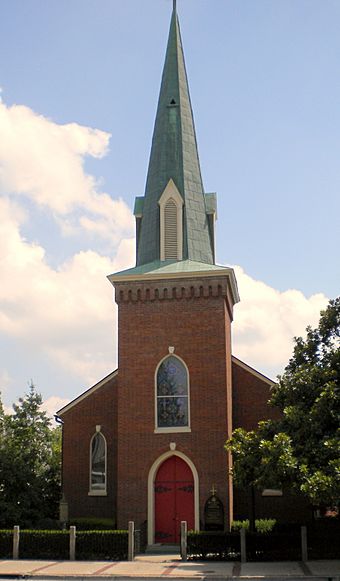Trinity Episcopal Church (Danville, Kentucky) facts for kids
Quick facts for kids |
|
|
Trinity Episcopal Church
|
|
 |
|
| Location | 320 W. Main Street Danville, Kentucky |
|---|---|
| Built | 1830 |
| Architect | Robert Russel, Jr. |
| Architectural style | Gothic Revival |
| NRHP reference No. | 77000604 |
| Added to NRHP | September 15, 1977 |
Trinity Episcopal Church in Danville, Kentucky, is a very old and important church. It was one of the first churches started in the Episcopal Diocese of Kentucky. This church building is the oldest one still used in Danville. It is also the oldest continuously used Episcopal church building in the Episcopal Diocese of Lexington. Plus, it's the second oldest in all of Kentucky! It is listed on the National Register of Historic Places, which means it's a special historical building.
History of Trinity Episcopal Church
Early Days of the Episcopal Church in Kentucky
The Episcopal Church first started in Kentucky way back in 1796. That's when Christ Church was formed in Lexington. However, it took until 1809 for the church to be officially set up. In 1822, another Episcopal church, also called Christ Church, was started in Louisville. Its building, now known as Christ Church Cathedral, was finished in 1824.
Starting Trinity Church in Danville
In 1829, Reverend George T. Chapman, a leader from Lexington's Christ Church, suggested creating a larger church group called a Diocese. To help with this, Reverend Chapman visited Danville. There, he helped a group of local people start a new church. These people were important members of the community. They included doctors, lawyers, bankers, and landowners.
Building the First Church
A special committee was formed to build the church. Dr. Ephraim McDowell and his wife, Sarah Shelby McDowell, were part of this group. Sarah was the daughter of Isaac Shelby, who was Kentucky's first Governor. James Birney, a rich merchant, also helped a lot. He gave the most money to the church. His son, James G. Birney, later became a famous person who worked to end slavery.
The new church building was finished in late 1830 or early 1831. It was built by Robert Russel Jr., who made bricks and worked as a builder in Danville. Russel built many early brick buildings in Danville, including Old Centre in 1820. The church was officially dedicated on June 3, 1831. Reverend William Meade, a leader from the Episcopal Diocese of Virginia, came to do this. He was a very important person in the Episcopal Church.
Early Leaders and Challenges
The first leader of Trinity Church was Reverend Gideon McMilan. He not only served Trinity Church but also traveled by horse to nearby towns. He started new church groups in Harrodsburg and Lancaster. Sadly, Reverend McMillan became sick during a serious illness outbreak in 1833. He passed away after helping many people in the community. He was buried near the church building.
Trinity Church continued to grow and hold regular services. However, in 1860, a big fire damaged the church. This fire also destroyed much of Danville's business area.
Rebuilding and New Design
The day after the fire, people checked the church. They found that the four main walls and the entrance area were still strong. So, they decided to rebuild. A new roof and a bell tower were added. They also added a special area for the altar called a chancel. The old window openings were changed to new, tall, narrow windows with pretty wooden designs.
After the repairs were finished in 1861, the church looked very different. It had changed from an older style to a beautiful Gothic Revival style. This style is known for its pointed arches and tall windows. The church still looks this way today and is a great example of Gothic Revival church design.
A Hospital During the Civil War
For several months in 1862, the newly repaired church was used as a hospital. It cared for soldiers from the Union army who were hurt in the Battle of Perryville. This battle happened on October 8, 1862. A drawing from a magazine called Harper's Weekly Magazine in November 1862 showed Union soldiers arriving in Danville. You can clearly see Trinity Church in that drawing.
What Trinity Church Looks Like
Original Features
The first church building was a rectangular shape. It had a two-story entrance area sticking out from the front. The walls were made of bricks laid in a special pattern called Flemish bond. There were two rectangular windows on the sides. In 1842, a small tower called a cupola was added to the entrance to hold the church bell. Inside, the ceiling was held up by two rows of columns. At the back of the church, there was a balcony for the organ and choir.
Changes After the Fire
After the 1860 fire, the inside of the church and the roof were destroyed. But the main walls and entrance were still strong enough to rebuild. The plans for rebuilding in 1860 made many changes. These changes turned the church into a Gothic Revival building.
A recessed chancel was added at the front. Three tall, narrow windows, called lancet windows, were placed above the altars. The middle window was taller and wider. Two more narrow lancet windows were added to the front of the church to light the choir area. Another one was added in the bell tower. The original rectangular windows were replaced with pairs of lancet windows. Above each pair was a four-leaf clover design inside a circle, called a quatrefoil. All the windows were filled with colorful stained glass and had wooden designs.
The Bell Tower and Steeple
The original cupola was replaced by a tall bell tower. On top of the tower is a tall, eight-sided steeple with a cross at the very top. The steeple has narrow, slatted openings on its four sides at the bottom. There are also triangle-shaped vents in the middle of the tower.



